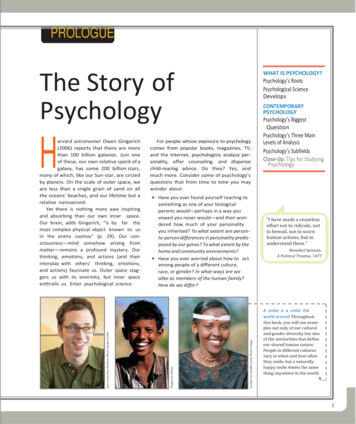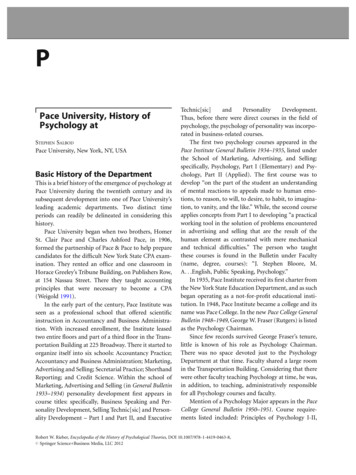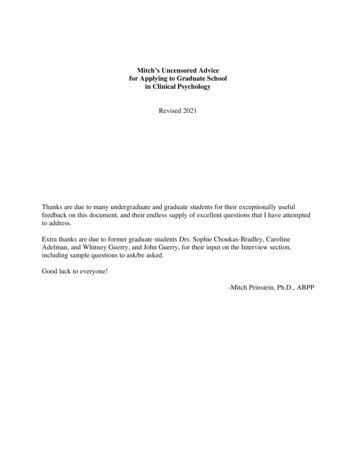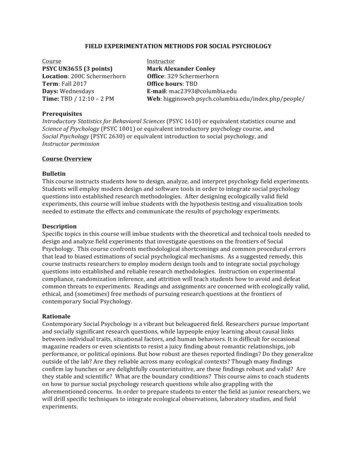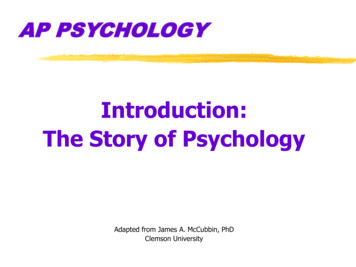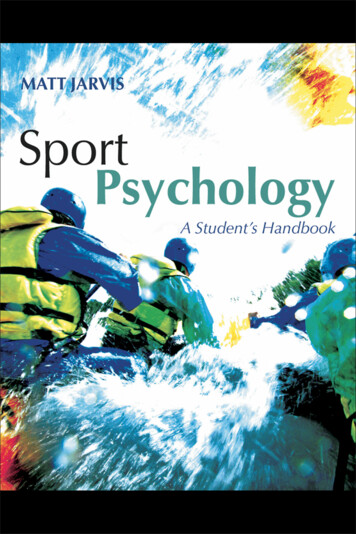
Transcription
SPORT PSYCHOLOGYThis book offers a student-friendly introduction to the discipline of sport psychology. All the key psychological issues in sport are explored and illustrated withsporting examples. Throughout, difficult questions are raised: are athletes bornor made? Does participating in sport affect personality? What impact do culturalbeliefs have on personal sporting development? These complex issues areweighed up to provide a detailed overview of the topic. Matt Jarvis has substantially revised and expanded his original coverage of the subject from his highlysuccessful book Sport Psychology (published by Routledge in 1999). Here he provides a succinct but comprehensive account of major theory and research in sportpsychology, whilst maintaining the readable style and student-centred approachwhich made the previous book so successful.Key issues covered include: personality and sportattitudes to sportaggression in sportthe social factors affecting performancearousal and anxietymotivation and skill acquisition.There is an emphasis not merely on learning about sport psychology, but alsoon developing critical and creative thinking. In addition, the book includeschapters on conducting research and writing essays in sport psychology, as wellas reflective exercises throughout the text.Written by a successful author who has experience of teaching at sixth formand undergraduate level, this book will be useful to undergraduates in sportscience and leisure management, those studying for the BAQTS and PGCE inphysical education, and those studying A-level psychology or sports studies.Matt Jarvis teaches psychology at Totton College and is Visiting Lecturer atSouthampton University.
Sport PsychologyA Student’s HandbookMatt Jarvis
First published by Routledge27 Church Road, Hove, East Sussex, BN3 2FASimultaneously published in the USA and Canadaby Routledge270 Madison Avenue, New York, NY 10016This edition published in the Taylor & Francis e-Library, 2006.“To purchase your own copy of this or any of Taylor & Francis or Routledge’scollection of thousands of eBooks please go to www.eBookstore.tandf.co.uk.”Routledge is a part of the Taylor & Francis GroupCopyright 2006 RoutledgeAll rights reserved. No part of this book may be reprinted or reproduced or utilised in any formor by any electronic, mechanical, or other means, now known or hereafter invented, includingphotocopying and recording, or in any information storage or retrieval system, withoutpermission in writing from the publishers.The publisher makes no representation, express or implied, with regard to the accuracy of theinformation contained in this book and cannot accept any legal responsibility or liability for anyerrors or omissions that may be made.This publication has been produced with paper manufactured to strict environmental standardsand with pulp derived from sustainable forests.British Library Cataloguing in Publication DataA catalogue record for this book is available from the British LibraryLibrary of Congress Cataloging in Publication DataJarvis, Matt, 1966–Sport psychology : a student’s handbook / Matt Jarvis.p. cm.Includes bibliographical references and index.ISBN 1 -84169-581-5 (hardcover) – ISBN 1-84169-582-3 (softcover)1. Sports – Psychological aspects – Handbooks, manuals, etc. I. Title.GV706.4.J37 2005796.01—dc22ISBN10: 1-84169-581-5 (hbk) ISBN13: 978-1-84169-581-5 (hbk)ISBN10: 1-84169-582-3 (pbk) ISBN13: 978-1-84169-582-2 (pbk)
ContentsList of figures and tablesPreface to second editionixxi1. Introduction1What is sport psychology?1A brief history of sport psychologyWhat is a sport psychologist?3For those new to psychology5Summary and conclusions1122. Personality characteristics and sporting behaviourTrait theories14Research into traits and sporting behaviour19Narrow-band theories of personality22Attentional style27Discussion of the trait and narrow-band approachesSituational and interactional approaches30Summary and conclusions333. Personality development and sport35Social learning theory36Applying social learning theory to sport37Sources of influence on social development and sportGender and sport42Sport as an influence on social development46The psychodynamic approach to personalitydevelopment49Summary and conclusions534. Attitudes to sport55The nature of attitudes56Measuring attitudes58The formation of attitudes to sport61Attitudes to competition64Attitudes to sport and sporting behaviour13294065CONTENTSv
Changing people’s attitudes to sportSummary and conclusions71695. Aggression and sport73Defining aggression74The link between aggression and performance76Theories of aggression79Individual differences in sporting aggression83Situational factors affecting aggression85The 64,000 question – does sport increase or reduceaggression?86The reduction of aggression88Summary and conclusions906. Social factors in sporting performanceGroups and teams93Social facilitation97Negative effects of team membershipLeadership104Summary and conclusions110931027. Arousal, anxiety and sporting performance113Definitions of arousal, anxiety and stress114Factors inducing anxiety and stress118The relationship between arousal and performanceThe relationship between anxiety and performanceStress management127Summary and conclusions1338. Motivation and sport135Intrinsic and extrinsic motivationTheories of motivation138Self-efficacy147Counterfactual thinking148Pathological motivation and sportSummary and conclusions1521361509. Skill acquisition and expertise155Definitions156Classifying abilities156Classifying skills158Two linked issues: the existence of superabilityand the nature–nurture debate in sport160Stages of skill acquisition163The information-processing approach to skillsMemory167Theories of motor learning170viCONTENTS166120122
Expert performance172Enhancing skill and expertise: the role of practiceSummary and conclusions17717410. Research methods in sport psychology179Quantitative and qualitative research180The experimental model180The correlational method184Survey methods187Case studies190Archival studies191Review methods192Summary and conclusions19411. Writing essays in sport psychologySeven deadly sins of essay 8Summary and ii
List of figuresand tablesFigures2.1. Eysenck’s four personality types162.2. What personality differences can you see between golfers andsurfers?232.3. The relative importance of personality, situation and otherfactors in athletic performance312.4. Mood profiles of elite and unsuccessful athletes323.1. Children witnessing this behaviour may imitate it383.2. David Beckham393.3. Children imitate family role models413.4. Feminine roles can be hard to reconcile with athleticism433.5. Female athletes are evaluated by commentators for looks andpersonality rather than performance454.1. Boxing arouses strong attitudes594.2. Social learning of a child’s attitude to football634.3. Applying the theory of reasoned action to explaining participation in sport664.4. There is always a decision-making process involved in choosingto participate in sport695.1. The greater the potential for serious injury, the more elaborateare the rules for preventing it755.2. Although (American) ice hockey is notoriously violent, there isno clear link between aggression and success785.3. Bandura’s famous bobo doll study815.4. 9/11 triggered a reaction against war analogies845.5. Martial arts training tends to reduce aggression876.1. The effect of being watched on pool players will depend on theirlevel of expertise997.1. Drive theory of the relationship between arousal and performance for expert performers1217.2. The inverted-U hypothesis of arousal and performance122LIST OF FIGURES AND TABLESix
7.3. Fazey & Hardy’s catastrophe model of the relationship betweenanxiety and performance1237.4. The relationship between arousal and bowls performance underlow and high cognitive anxiety1247.5. Zones of optimal functioning in three athletes1247.6. Jack Nicklaus places tremendous emphasis on imagery1317.7. Visualising a stadium before competition may reduceanxiety1328.1. Karate belts are an example of the effective use of extrinsicmotivation1388.2. Maslow’s hierarchy of needs1398.3. Fitting reasons for sport participation into the hierarchy ofneeds1408.4. Martial arts differ in the use of a predominantly task- or egooriented environment1448.5. Fencing self-efficacy is affected by winning and losing1458.6. Weiner’s model of attribution1468.7. After this incident in 1998, the country engaged in counterfactual thinking1499.1. Weightlifting requires the ability of dynamic strength1579.2. Examples of sporting skills ranging from gross to fine1589.3. This martial artist is practising a closed skill, but with sufficientpractice should be able to use it in an open situation1599.4. This child basketball prodigy did not develop the necessaryphysical characteristics for adult competition1629.5. Michael Jordan is a classic example of an athlete practising at theautonomous stage1659.6. Welford’s information-processing model1669.7. Anderson’s model of memory1689.8. Closed loop theory17010.1. Some correlation patterns18410.2. An effect size of one standard deviation19311.1. Bloom’s taxonomy of thinking skills20011.2. A spider diagram206Tables1.1.1.2.8.1.8.2.9.1.xApplying psychological approaches to understandingsport7Major theoretical orientations in psychology7Comparison of task- and ego-oriented athletes142Examples of some internal and external attributions followingfailure145Examples of motor abilities and dependent skills156LIST OF FIGURES AND TABLES
Preface to thesecond editionFollowing the success of the first edition of Sport Psychology, whichwas written primarily for A-level students, the aim of this secondedition is to make the book of more use to students at undergraduatelevel. To achieve this, I have tried to maintain the informal, userfriendly style of the first edition, but I have also added substantially tothe content. Thus, the text is much more detailed and up-to-date, featuring a more comprehensive range of theories and numerous studiesfrom the last 5 years. Chapters 2–9 cover the essential topics in sportpsychology; personality and sport, attitudes to sport, aggression andsport, social factors affecting performance, arousal and anxiety,motivation, and the acquisition of skill and expertise. Throughout thebook, I have rejected utterly the ‘just do it’ attitude that characterisessome sport science literature. Instead there is an emphasis on thrashing out difficult issues, including the questions of whether athletes areborn or made, and whether sport is really character building.For real understanding of sport psychology, it is necessary to havea reasonable understanding of the nature of psychology itself. One ofthe things I have tried to do in this second edition is to put across tothose new to studying psychology at this level the nature of the discipline. In Chapter 1, the reader is introduced to the distinction betweentheory and research and the range of theoretical approaches that makeup psychology. However, psychology is as much a way of thinking asa set of theories and studies. I have tried to introduce the reader to theskills of critical and creative thinking prized by psychologists, and toencourage the use of these higher thinking skills throughout the bookwith a series of reflective exercises.Also of use to those new to psychology should be the final twochapters. In Chapter 10, I review the major research methods used insport psychology. This should help students both to understand morePREFACE TO SECOND EDITIONxi
deeply the research they have studied already and to plan their ownresearch. Chapter 11 aims to teach students what is expected in apsychology essay, and to guide them through the process of planningand constructing an essay. Again there is an emphasis on applyinghigher-level thinking skills to psychological theory and research, andthis chapter should crystallise the understanding of creative andcritical thinking encouraged throughout the text.xiiPREFACE TO SECOND EDITION
Introduction1Learning objectivesBy the end of this chapter you should be able to: define sport psychology give a brief history of the discipline understand what sport psychologists do and who is entitled to use thedesignation explain the purpose of theory and research in psychology, and describe somemajor research methods used in sport psychology recognise the major approaches to psychology begin to think critically about psychological theory and research.What is sport psychology?Because there are many ways in which we can apply psychology tosport and, given the wide range of activities that different culturesregard as sport, it is helpful to adopt quite a broad definition of sportpsychology. In 1996, the European Federation of Sport Psychology(FEPSAC) produced such a broad definition, which, slightly simplified, reads, ‘Sport psychology is the study of the psychological basis, processes and effects of sport.’ This of course begs the questions, what issport and what is psychology? Although many athletes would insistthat sport necessarily includes an element of competition, the term‘sport’ is used, both in the FEPSAC definition of sport psychology,and throughout this book, in the broadest sense, including any physical activity for the purposes of competition, recreation, education orhealth. Psychology is often defined as ‘the science of mind andbehaviour’ (Gross, 2005). Later in this chapter, we can take a briefoverview of psychology and begin to learn how to think critically andcreatively about psychological theory and research.Sport psychology (or sports psychology, as some prefer) is thus a1. INTRODUCTION1
broad church. Many American sport psychologists draw a sharp distinction between academic sport psychology, which focuses on all thefactors affecting participation and performance in sport, and appliedsport psychology, which focuses purely on applying psychology toenhance athletic performance (e.g. Cox, 2001). At the time of writing,European writers generally do not subscribe to this rather rigid distinction (Kremer & Scully, 1994), and this book crosses freely betweenacademic and applied sport psychology. The topics covered here, personality, attitudes, aggression, stress and anxiety, group dynamics,motivation and skill acquisition, should be both of academic interestand applicable to working with athletes and, in some cases,spectators.A brief history of sport psychologySport psychology has existed in some form for almost as long aspsychology itself. The first recorded study in sport psychology tookplace at the close of the nineteenth century. Norman Triplett (1898)performed what is often cited as the first experiment in social psychology as well as the first in sport psychology. Triplett investigatedthe phenomenon of social facilitation, in which performance isaffected by the presence of others (this is discussed in detail in Chapter 6). He demonstrated that cyclists tended to cycle faster whenracing against other cyclists than they did alone. Triplett did notpursue further sport-related research, however, and it was not untilthe 1920s that the discipline of sport psychology was formallyestablished.In 1925, Coleman Griffith set up the Athletic Research Laboratoryat the University of Illinois. Griffith, who also put sport psychology onthe map by establishing a university course, publishing two majortextbooks and acting as a consultant to professional sports teams, isoften called the ‘father of sport psychology’. The early path of sportpsychology did not run smoothly, however, and the Athletic ResearchLaboratory closed in 1932 due to lack of funds.Between the 1930s and the 1960s (at least in the Western world),there was little activity in the field of sport psychology. In the SovietUnion, sport psychology emerged as a discipline shortly after the Second World War. It is of course difficult to obtain accurate informationabout the practice of Soviet psychology during the Cold War, but it iscommonly believed that, during the 1960 Melbourne Olympics, Eastern European teams employed sport psychologists (Kremer & Scully,1994). Certainly, we know that, by the early 1970s, East German and2SPORT PSYCHOLOGY
Soviet teams were routinely employing sport psychologists toenhance athletic performance in international events.Sport psychology reappeared in the USA in the 1960s, and wastaken up in Britain and the rest of Europe a few years later. The areahas since expanded worldwide to become one of the fastest growingnew academic disciplines. Interestingly, until very recently, thestudy of sport psychology was firmly located in the domain of sportsciences as opposed to within psychology. This may be changing,however. In 1986, the American Psychological Association officiallyrecognised sport psychology as a branch of psychology, and in 1993the British Psychological Society formed a Sport and ExercisePsychology Section, which has now become a full division of thesociety.What is a sport psychologist?We can think of this question in two ways; first, who can call himselfor herself a sport psychologist, and second, what do sport psychologists do? To address the first question, currently, in Britain, there is nocompulsory registration of sport psychologists; therefore, in theory,anyone can call himself a sport psychologist. In reality, of course, itwould be highly unethical for anyone not properly trained to use thetitle ‘psychologist’ in any context. At the time of writing, legislation isbeing brought in which will place legal limits on the use of the term.The British Association of Sport and Exercise Sciences (BASES) keepsa register of approved sport psychologists. At the 1998 annual conference, the British Psychological Society (BPS)’s Sport and ExercisePsychology Section (now ‘Division’) approved the principle of granting the title Chartered Sport Psychologist to appropriately qualifiedpeople. At the time of writing, legislation is at the consultation stageto restrict certain titles, including Chartered Sport and Exercise Psychologist, to those on a register, to be maintained by the Health ProfessionsCouncil. To register with BASES as a sport psychologist, one needseither a first degree in psychology and a higher degree in sport scienceor a first degree in sport science and a higher degree in sport psychology. To achieve chartered status from the BPS, it is necessary tohave a BPS-approved first degree in psychology and BPS-approvedpostgraduate training, including supervised practice. There is currently no such approved postgraduate training. A similar situationexists in the USA, where, although the American PsychologicalAssociation (APA) has a Division of Sport Psychology (Division 47), itdoes not accredit courses.1. INTRODUCTION3
There is some controversy surrounding the accreditation ofsport psychologists. The BASES scheme for registration of sportpsychologists has existed only since 1992, and many people who werealready working as sport psychologists chose not to join the register orwere unqualified to do so. Anshel (1992) has pointed out that many ofthose working full-time with athletes do not have the time, resourcesor inclination to pursue the lengthy procedures necessary to becomeregistered, and that registration thus excludes some of the Britain’smost experienced practitioners. On the other hand, compulsory registration would provide a measure of protection for the public fromdubious or underqualified practitioners.With regard to the second question, the work carried out bysport psychologists is quite varied. The European Federation ofSport Psychology (1996) recognises three interrelated tasks for sportpsychologists: research; investigation into all aspects of the psychology of sport,both theoretical and applied education; teaching students, officials and athletes about sportpsychology application; assessment of and intervention in psychological problems connected to sport. This can involve consulting to wholeteams or counselling of individuals.The BPS Division of Sport and Exercise Psychology is particularlycommitted to research, education and application in particular areas,as shown in Box 1.1:Box 1.1 Areas of focus for the BPS Division of Sport and Exercise Psychology psychology of elite performanceindividual and group processes in sportmotor skill acquisition and performancemotivational issues in sport and exercisepsychological factors in adoption and maintenance of exercise behavioursport, exercise and mental healthprofessional practice in sport and exercise psychology.Because sport psychology is now such a broad field, it is becomingimpossible for sport psychologists to keep up with all aspects of theirdiscipline. Nowadays, you will find that many sport psychologists4SPORT PSYCHOLOGY
have become highly specialised. For example, psychologists may specialise in the study of motivation (see Chapter 8). They may carry outresearch into motivation, teach coaches about motivation and perhapswork with individual athletes to improve their motivation.For those new to psychologyFor readers new to psychology, before ploughing into the specifics ofsport psychology, it is perhaps worth taking some time to overviewthe nature of psychology in general, and to begin to learn to think likea psychologist. To understand psychology, it is necessary to understand what we mean by the terms ‘theory’ and ‘research’, and to befamiliar with the different theoretical approaches psychologists candraw upon to understand a phenomenon.Theory and researchThe writings of psychologists largely consist of two very importantelements: theory and research. A psychological theory is intended toexplain why something takes place. For example, in Chapter 7, we canlook at a range of theories that aim to explain the relationship betweenarousal, anxiety and sporting performance. It is tempting to ask,‘which is right?’ when confronted by a range of alternative theories;however, it is rare in psychology for a single theory to hold all theanswers. Usually, each theory is helpful in its own way because ithelps us understand and think about a different aspect of thesituation.The term ‘research’ is a very broad one, and is used by psychologists in different fields to mean rather different things. However, asimple definition appropriate to sport psychology is the gathering andanalysing of data (information).1 Often, though not necessarily, this isdone in order to test an idea or hypothesis. For example, we mighthypothesise that team players are more sociable than athletes in individual sports. There are many procedures by which data can be gathered. Some of the more important research methods used in sportpsychology are outlined in Box 1.2.1This definition would not be universally acceptable in psychology. In social psychology,for example, it would not be adequate, as there is a field of ‘theoretical research’ thatoverlaps between the generating of theory and data gathering.1. INTRODUCTION5
Box 1.2 Some of the research methods used in sport psychology Experiment: involves comparing people’s responses or performance under two or more artificially created conditions. For example, we might set up twoconditions in which basketball players are either punished or rewarded asthey train, and thus measure the effect punishment and reward has upon theirmotivation and performance.Quasi-experiment: involves comparing two or more naturally occurringgroups. For example, we might be interested in comparing the personalitycharacteristics of athletes in individual and team sports, or comparing men’sand women’s attitudes to boxing.Survey: involves asking questions or asking for responses to suggestions.This can be done verbally (interview) or on paper (questionnaire). Surveysare useful in investigating attitudes and motives.Observation: involves systematically watching people’s behaviour in particular circumstances. We might use observation, for example, to see how frequency of aggression changes in response to losing in a contact sport.Correlation: involves measuring two or more variables and seeing how theyare related. In a positive correlation, as one variable increases, so does theother. An example of such a correlation is that between physical size andhostility. In a negative correlation, as one variable increases, the otherdecreases. An example of this is the relationship between experience as amartial artist and hostility – as experience increases, hostility declines.Approaches to psychologyThe BPS recognises five aspects of or approaches to the study ofpsychology. These are individual differences, social psychology,cognitive psychology, physiological psychology and developmentalpsychology. Examples of how each of these approaches can beapplied to sport psychology are shown in Table 1.1.From Table 1.1 it is quickly apparent that there is considerable overlap between the five approaches and that in practice they are notdistinct from one another. For example, attitudes are an aspect ofsocial psychology because they affect our interpersonal behaviour, butthey also vary from one person to another; thus, they are also studiedas an aspect of individual differences. Similarly, personality is mostobviously an aspect of individual differences; however, we can understand the reasons why we differ in our personality with reference tophysiological processes and developmental processes.6SPORT PSYCHOLOGY
ApproachIndividual differencesMain focus of approachVariation in thecharacteristics ofindividualsTable 1.1 ApplyingExamples in sportpsychologyPersonality, attitudes tosport, motivation,anxietySocial psychologyWays in which peopleAttitudes to sport,interact with one another aggression, teamcohesion, teamleadershipCognitive psychologyWays in which the mindprocesses informationpsychologicalapproaches tounderstanding sportSkill acquisition,motivation, imageryPhysiological psychology The relationship between Arousal andbiological andperformance, biologicalpsychologicalbasis of personality traitsfunctioningDevelopmentalpsychologyThe processes ofSocial learning, genderdevelopment ofdevelopment,psychological functionspersonality developmentand characteristics acrossthe lifespanTheoretical orientations in psychologyAn alternative way to classify approaches to psychology is in terms ofits theoretical orientations. Unlike other sciences, which tend to havebroad agreement about the fundamentals of what they study, howand to what end, psychology is made up of different theoreticalschools, each of which takes a different view of the subject. Table 1.2shows some of the major theoretical orientations in psychology andexamples of their contributions to sport psychology.Some psychologists operate very much within a single theoreticalframework and can be said to have a distinct orientation, whilst othersdip into different orientations and approaches as required. This latteris called an eclectic approach.Theoretical orientation Underlying assumptionsBehavioural (learning) Focus is on observablebehaviour Behaviour is acquired bylearningExamples ofapplications in sportpsychologySocial learning ofattitudes, personality,aggressionTable 1.2 Majortheoreticalorientations inpsychology1. INTRODUCTION7
Table 1.2 continuedTheoretical orientation Underlying assumptionsCognitivePsychodynamic Focus is on mentalCognitive anxietyprocesses Mental processes underliebehaviour and emotionCognitive aspects ofmotivation Focus is on theunconscious mind There are unconsciousinfluences on us, includinginstinct and earlyexperienceHumanistic Focus is on humanpotential and growthPhysiologicalSocialExamples ofapplications in sportpsychology Focus is on physiologicalPersonalitydevelopmentUnconscious factors inattitudesInstinct and aggressionAchievementmotivationprocesses Physiology underliespsychological processesTrait theories ofpersonalityArousal and somaticanxiety Focus is on interpersonalSocial facilitationand group processes Social situation affectspsychological processesTeam membershipReflective exerciseConsider the following scenario. John, a middle-aged man who has not taken partin sport since school (when he was a talented athlete), decides to start regularexercise. He gets into the habit of running, in which he takes considerable pleasure and which helps him lose weight and feel more energetic. After severalmonths, John achieves a standard high enough to enter in a local race, where herecords a creditable time. From a behavioural perspective, John is receiving reinforcement in the form of 8weight loss, increased energy and improved times. He is thus learning thatrunning is a good thing so he continues.From a cognitive perspective, John is processing information about running.He believes his running makes him healthier and more attractive, and will helphim live longer.From a psychodynamic perspective, there are likely to be unconscious influences on John’s behaviour, perhaps related to his age. He might beunconsciously trying to recapture his youth or responding to a fear of ageingand death.SPORT PSYCHOLOGY
From a humanistic perspective, John never fulfilled his early potential as anathlete and is seeking to achieve as much as he can in this area. From a physiological perspective, John is producing large quantities of endorphins, natural opiates, which induce ‘runner’s high’. Running and othervigorous exercise enhance mood because of the chemical changes theybring about.From a social perspective, we need to take a step back and consider thesocial situation in which John’s behaviour takes place. For example, in thelight of social norms of body type, we might see his behaviour as a responseto social pressure to lose weight.1. Which of these perspectives portrays John’s behaviour in a positive light?2. Which appeal to you as likely explanations of
sport, social factors affecting performance, arousal and anxiety, motivation, and the acquisition of skill and expertise. Throughout the book, I have rejected utterly the ‘just do it’ attitude that characterises some sport sc


